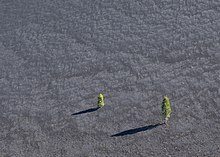Scoria
This article needs additional citations for verification. (September 2010) |

Scoria is a
Scoria may form as part of a lava flow, typically near its surface, or as fragmental ejecta (
The geological term cinder is synonymous and interchangeable with scoria, though scoria is preferred in scientific literature.[2][4] The word comes from Greek σκωρία, skōria, rust. In earlier terminology, scoria was usually defined with a size range, e.g. 2 to 24 mm (0.079 to 0.945 in) in diameter, but neither color nor composition was typically a part of the definition.[5][6] During the 1980s, the size range disappeared from the definition, and a requirement was added that scoria be black or reddish in color and/or mafic in composition.[1]
Comparisons
Scoria differs from pumice, another vesicular volcanic rock, in having larger vesicles and thicker vesicle walls, and hence is denser. The difference is probably the result of lower magma viscosity, allowing rapid volatile diffusion, bubble growth, coalescence, and bursting.
Formation

As rising magma encounters lower pressures, dissolved gases are able to exsolve and form vesicles. Some of the vesicles are trapped when the magma chills and solidifies. Vesicles are usually small, spheroidal and do not impinge upon one another; instead, they open into one another with little distortion.
Uses
Scoria is also used in the construction of flexible, long-lasting
Scoria is used in horticulture. Because it can hold water in its vesicles and in the pore space between grains in aggregates, it can improve the water-holding capacity of planting soils. When sorted to specific sizes and tightly packed, it is also an effective barrier against tunneling pests such as termites.[7] Its striking colours and water-holding properties can make it attractive for landscaping and drainage works.[8]
Scoria can be used for high-temperature insulation, as in gas barbecue grills.[9]
The
See also
- Cinder track – Race track whose surface is composed of cinders
- Extrusive rock – Mode of igneous volcanic rock formation
- Igneous rock
- Lapilli – Small pyroclast debris thrown in the air by a volcanic eruption
- List of rock types – List of rock types recognized by geologists
- Parícutin – Dormant volcano in Michoacán, Mexico
- Tephra – Fragmental material produced by a volcanic eruption
- Tuff – Rock consolidated from volcanic ash
- Volcano – Rupture in a planet's crust where material escapes
- Volcanic bomb – Mass of molten rock ejected during an eruption
- Ye Olde Cinder House – house in West Hallam, Erewash, Derbyshire, UK
References
- ^ ISBN 978-3-642-74864-6
- ^ ISBN 0-922152-76-4
- ^ Preliminary Assessment of Utilization of Al-Jaif Scoria (NW Sana'a, Yemen) for Cement Production
- ISBN 9780859015226
- ^ Stokes, W. L., and Varnes, D. J., 1955. Glossary of selected geologic terms, with special reference to their use in engineering: Denver. Proceedings of the Colorado Scientific Society. vol. 15, pp 1-165.
- ^ Wentworth, C.K. and Macdonald, G.A., 1953. Structures and forms of basaltic rocks in Hawaii. United States Geological Survey Bulletin. no. 944, pp 1-98.
- ^ a b c Dehn J., and McNutt, S.R., 2015. Volcanic materials in commerce and industry. In: Sigurdsson H., Houghton B., F., McNutt, S.R., Rymer, H., and Stix, J. (eds.) The encyclopedia of volcanoes. 2nd ed. England, Oxford, Elsevier. pp 1285-1294.
- ^ Three Kings Quarry, Winstone Aggregates.
- ^ Rock Types and Rocks Found in Michigan
External links
 Media related to Scoria at Wikimedia Commons
Media related to Scoria at Wikimedia Commons
